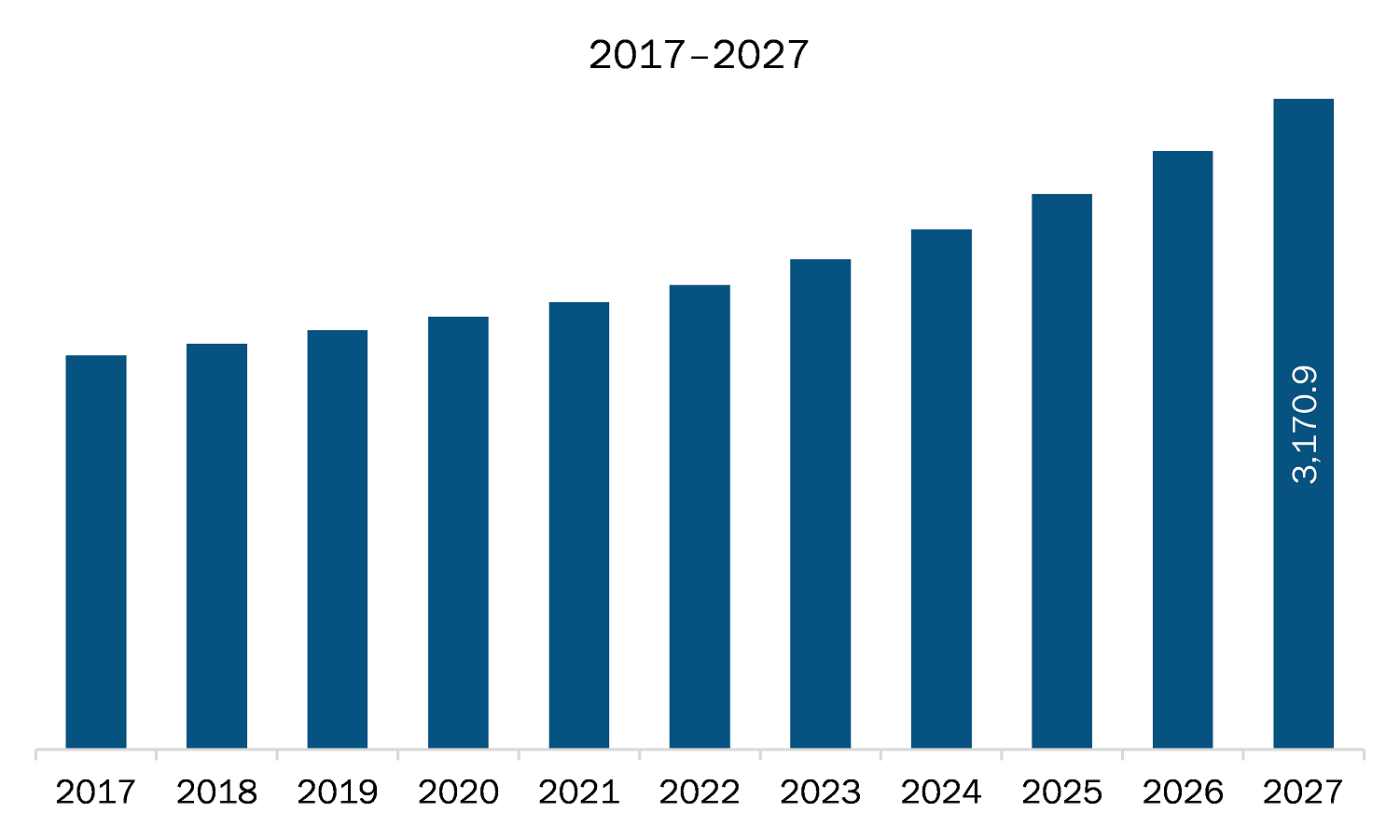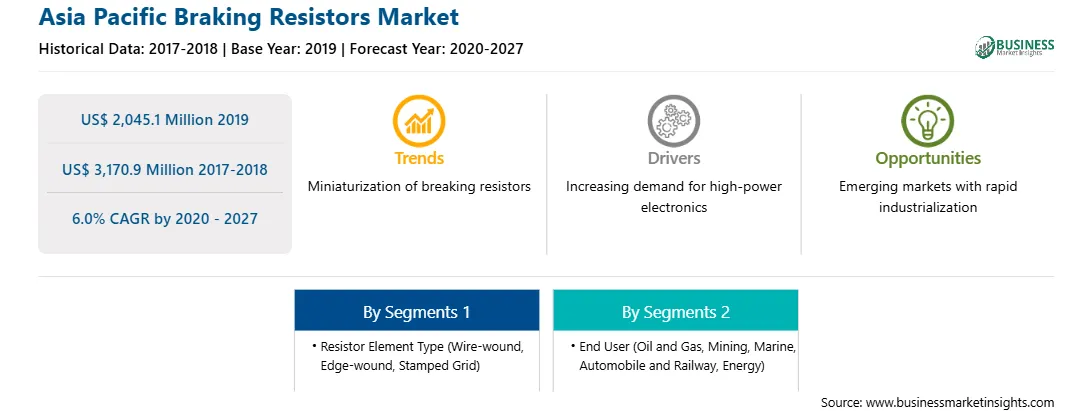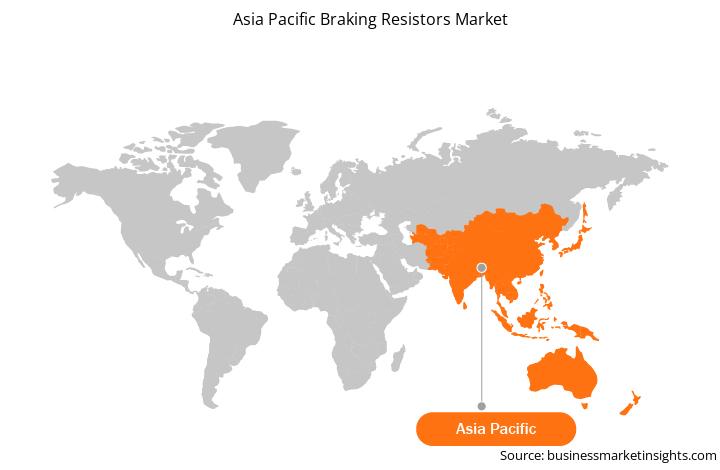The braking resistor market in APAC is sub segmented into China, India, Japan, Australia, South Korea, and the Rest of APAC. Government initiatives—such as “Made in China 2025” and “Make in India”—are propelling the growth of this sector in APAC. Improvements in infrastructure, increase in domestic consumption, and low labor costs in Southeast Asian countries are the key factors attracting automotive companies to this region. Based on the pollutant emissions, electric vehicles perform exceptionally well compared to diesel vehicles—especially in the light and heavy commercial vehicles. Optimizing automated cars is expected to be a significant driver for electric vehicle in various APAC countries, such as India, Malaysia, Singapore, and Thailand. Therefore, strong automotive manufacturing sector in these countries is expected to support the growth of the braking resistor market in the region in the coming years. APAC comprises major automotive manufacturers, such as Hyundai-Kia, Suzuki, Mitsubishi, Tata Motors Limited, Lexus, and Toyota. Moreover, the governments of various countries in APAC are taking initiatives for the development of the automotive sector; for instance, under Union Budget 2019–2020, the government of India announced its plans to set up R&D centers at an expenditure of US$ 388.5 million to enable the automotive sector to meet the standards. Such government initiatives in different countries are likely to generate huge demand for braking resistors in the region. Also, mining sector growing at huge speed is expected to create a significant demand for braking resistors in the coming years, which is further anticipated to drive the APAC braking resistors market.
APAC is adversely affected by the COVID-19 pandemic. The region is characterized by a large number of developing countries, positive economic outlook, high industrial presence, huge population, and rise in disposable income. All these factors make APAC a major growth driving region for various markets, including the braking resistors market. The consequence and impact of the outbreak can be even worse across the region, and it totally depends on the spread of the virus. The government of APAC is taking possible steps to reduce its effects by announcing lockdown that negatively impacts the revenue generated by the market. India, Japan and various other countries including South Korea are still combating the virus, which is hindering the growth of the braking resistors market. In addition, the lockdown is hampering the automotive sector in India. However, China has been able to stabilize the spread of the novel coronavirus, and industries in the country are up and running. This is a positive sign toward the stabilization of the braking resistors market. China’s manufacturing industry is likely to observe labor shortage, which would lead to a disruption in the supply of braking resistors in APAC in the coming years.

Strategic insights for the Asia Pacific Braking Resistors provides data-driven analysis of the industry landscape, including current trends, key players, and regional nuances. These insights offer actionable recommendations, enabling readers to differentiate themselves from competitors by identifying untapped segments or developing unique value propositions. Leveraging data analytics, these insights help industry players anticipate the market shifts, whether investors, manufacturers, or other stakeholders. A future-oriented perspective is essential, helping stakeholders anticipate market shifts and position themselves for long-term success in this dynamic region. Ultimately, effective strategic insights empower readers to make informed decisions that drive profitability and achieve their business objectives within the market.

| Report Attribute | Details |
|---|---|
| Market size in 2019 | US$ 2,045.1 Million |
| Market Size by 2027 | US$ 3,170.9 Million |
| Global CAGR (2020 - 2027) | 6.0% |
| Historical Data | 2017-2018 |
| Forecast period | 2020-2027 |
| Segments Covered |
By Resistor Element Type
|
| Regions and Countries Covered | Asia-Pacific
|
| Market leaders and key company profiles |
The geographic scope of the Asia Pacific Braking Resistors refers to the specific areas in which a business operates and competes. Understanding local distinctions, such as diverse consumer preferences (e.g., demand for specific plug types or battery backup durations), varying economic conditions, and regulatory environments, is crucial for tailoring strategies to specific markets. Businesses can expand their reach by identifying underserved areas or adapting their offerings to meet local demands. A clear market focus allows for more effective resource allocation, targeted marketing campaigns, and better positioning against local competitors, ultimately driving growth in those targeted areas.

The braking resistors market in APAC is expected to grow from US$ 2,045.1 million in 2019 to US$ 3,170.9 million by 2027; it is estimated to grow at a CAGR of 6.0% from 2020 to 2027. Owing to the growing urbanization and industrial growth, energy consumption has increased manifolds. Therefore, to meet the rising requirements for power, the development of sub-transmission and intrastate transmission networks is increasing. The escalating demand for energy & power, owing to growing household incomes and increasing manufacturing and heavy industries is boosting the market of braking resistor. Renewable energy plays a significant role for offering access to electricity. The demand of electricity in the Southeast Asia’s has been among the fastest. It has potential for the renewable energy sector. Further, in APAC, India is the 3rd largest producer of electricity, and the generating capacity is exponentially increasing owing to favorable government support and introduction of numerous power transmission projects.
In terms of resistor element type, the wire-wound segment accounted for the largest share of the APAC braking resistors market in 2019. Further, the automobile and railways segment held a substantial share of the APAC braking resistors market based on end user in 2019.
A few major primary and secondary sources referred to for preparing this report on the braking resistors market in APAC are company websites, annual reports, financial reports, national government documents, and statistical database, among others. Major companies listed in the report are ABB; Captech Pty Ltd; CRESSALL RESISTORS LTD.; REO AG; Sandvik AB; Schneider Electric; Toshiba International Corporation; Vishay Intertechnology, Inc.; Yaskawa Electric Corporation.
The Asia Pacific Braking Resistors Market is valued at US$ 2,045.1 Million in 2019, it is projected to reach US$ 3,170.9 Million by 2027.
As per our report Asia Pacific Braking Resistors Market, the market size is valued at US$ 2,045.1 Million in 2019, projecting it to reach US$ 3,170.9 Million by 2027. This translates to a CAGR of approximately 6.0% during the forecast period.
The Asia Pacific Braking Resistors Market report typically cover these key segments-
The historic period, base year, and forecast period can vary slightly depending on the specific market research report. However, for the Asia Pacific Braking Resistors Market report:
The Asia Pacific Braking Resistors Market is populated by several key players, each contributing to its growth and innovation. Some of the major players include:
The Asia Pacific Braking Resistors Market report is valuable for diverse stakeholders, including:
Essentially, anyone involved in or considering involvement in the Asia Pacific Braking Resistors Market value chain can benefit from the information contained in a comprehensive market report.